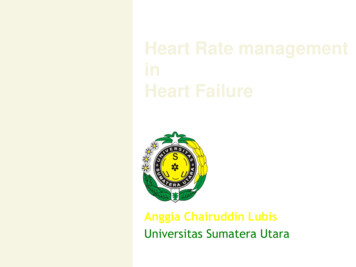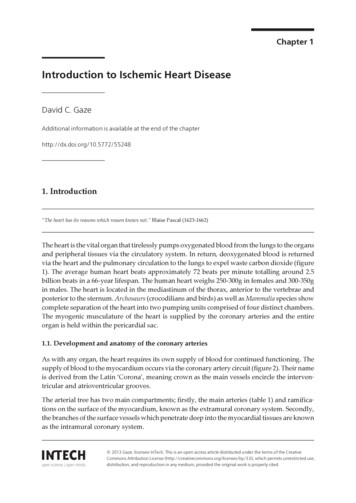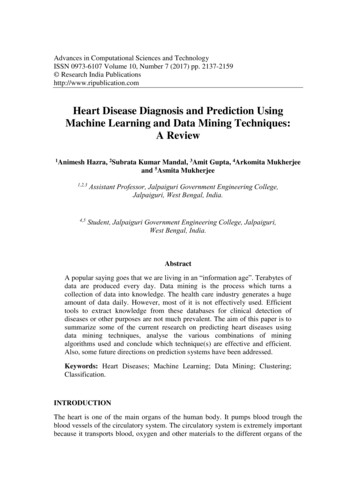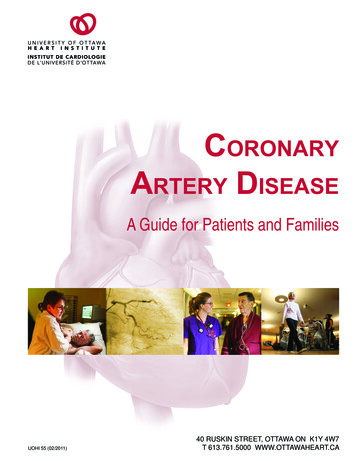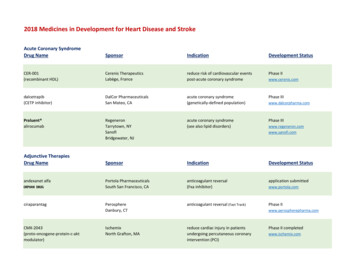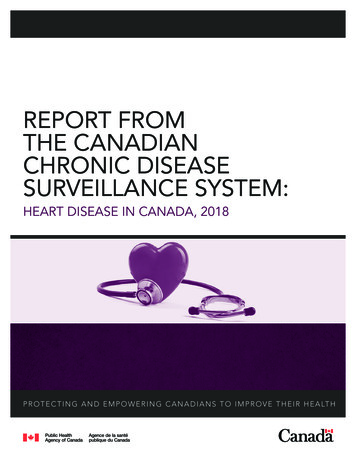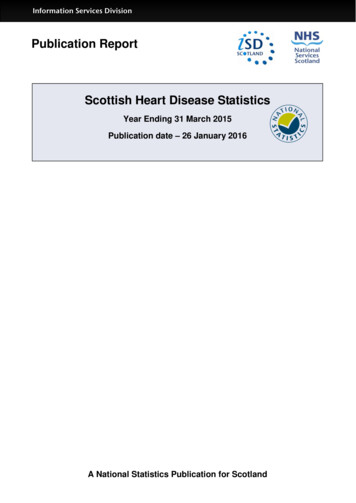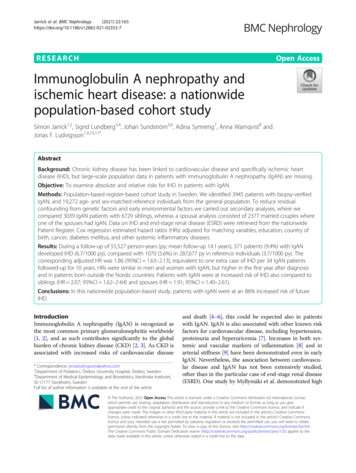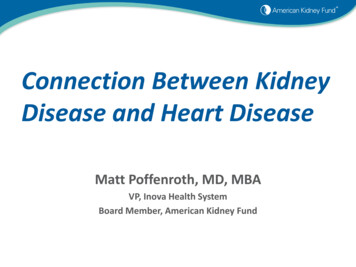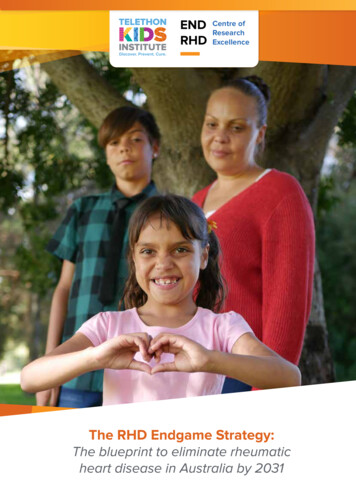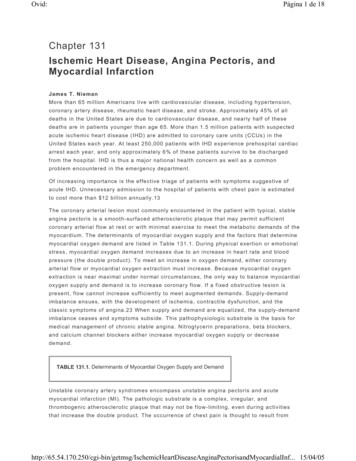
Transcription
Ovid:Página 1 de 18Chapter 131Ischemic Heart Disease, Angina Pectoris, andMyocardial InfarctionJames T. NiemanMore than 65 million Americans live with cardiovascular disease, including hypertension,coronary artery disease, rheumatic heart disease, and stroke. Approximately 45% of alldeaths in the United States are due to cardiovascular disease, and nearly half of thesedeaths are in patients younger than age 65. More than 1.5 million patients with suspectedacute ischemic heart disease (IHD) are admitted to coronary care units (CCUs) in theUnited States each year. At least 250,000 patients with IHD experience prehospital cardiacarrest each year, and only approximately 6% of these patients survive to be dischargedfrom the hospital. IHD is thus a major national health concern as well as a commonproblem encountered in the emergency department.Of increasing importance is the effective triage of patients with symptoms suggestive ofacute IHD. Unnecessary admission to the hospital of patients with chest pain is estimatedto cost more than 12 billion annually.13The coronary arterial lesion most commonly encountered in the patient with typical, stableangina pectoris is a smooth-surfaced atherosclerotic plaque that may permit sufficientcoronary arterial flow at rest or with minimal exercise to meet the metabolic demands of themyocardium. The determinants of myocardial oxygen supply and the factors that determinemyocardial oxygen demand are listed in Table 131.1. During physical exertion or emotionalstress, myocardial oxygen demand increases due to an increase in heart rate and bloodpressure (the double product). To meet an increase in oxygen demand, either coronaryarterial flow or myocardial oxygen extraction must increase. Because myocardial oxygenextraction is near maximal under normal circumstances, the only way to balance myocardialoxygen supply and demand is to increase coronary flow. If a fixed obstructive lesion ispresent, flow cannot increase sufficiently to meet augmented demands. Supply-demandimbalance ensues, with the development of ischemia, contractile dysfunction, and theclassic symptoms of angina.23 When supply and demand are equalized, the supply-demandimbalance ceases and symptoms subside. This pathophysiologic substrate is the basis formedical management of chronic stable angina. Nitroglycerin preparations, beta blockers,and calcium channel blockers either increase myocardial oxygen supply or decreasedemand.TABLE 131.1. Determinants of Myocardial Oxygen Supply and DemandUnstable coronary artery syndromes encompass unstable angina pectoris and acutemyocardial infarction (MI). The pathologic substrate is a complex, irregular, andthrombogenic atherosclerotic plaque that may not be flow-limiting, even during activitiesthat increase the double product. The occurrence of chest pain is thought to result artDiseaseAnginaPectorisandMyocardialInf. 15/04/05
Ovid:Página 2 de 18intermittent flow limitations caused by platelet or fibrin thrombi, an increase in coronaryvasomotor tone (i.e., vasospasm), or a combination of both, in the area of the unstablearterial plaque. Myocardial supply-demand imbalance, therefore, occurs because of adecrease in oxygen supply rather than an increase in demand, as in the stable coronarysyndrome. Such patients may present with a history of chest pain and may have had anormal exercise stress test or coronary angiography that demonstrated noncritical coronaryobstruction.6,31Myocardial ischemia can also occur in the absence of coronary atherosclerosis. Commoncauses of nonatherosclerotic myocardial ischemia are listed in Table 131.2.TABLE 131.2. Causes of Nonatherosclerotic Myocardial IschemiaCLINICAL PRESENTATIONHistory of Present IllnessNo single presenting symptom is uniformly diagnostic of IHD. Chest pain or chestdiscomfort is the most common chief complaint.P.664Such pain or discomfort may be described as a burning, tightness, squeezing, orheaviness, and as dull, sharp, or knifelike in character. Substernal or retrosternal chestpain may radiate to the left shoulder or to the arm, neck, or jaw due to convergence ofsympathetic and somatic afferent pathways at the spinal level. Patients with IHD may alsocomplain of similar types of abdominal discomfort. Chest pain caused by IHD is of visceralorigin and is poorly localized. Chest pain that can be localized with a fingertip is unlikely tobe of ischemic cardiac origin.21Chest pain caused by IHD usually occurs abruptly, increases in intensity over time, andreaches peak intensity within 2 to 5 minutes of onset. If the pain occurs during orimmediately after exertion, it typically resolves gradually within minutes of cessation ofphysical activity. Chest discomfort that lasts for only seconds or chest pain that is constantand lasts for hours to days is not consistent with IHD. Similarly, chest pain that is pleuritic,reproduced by palpation, and is sharp, stabbing, or positional has a low likelihood of beingdue to IHD25 (Table 131.3).TABLE 131.3. Characteristics of Chest Pain Typical and Atypical for Ischemic Heart DiseasePatients with IHD, usually the elderly or those who also have diabetes mellitus orhypertension, may present with symptoms other than chest pain during acute ischemia.Such patients may complain of dyspnea, early fatigue, or declining exercise tolerance,symptoms that are caused by diastolic myocardial dysfunction. Decreased ventricularcompliance leads to an increase in left ventricular (LV) end-diastolic pressure rtDiseaseAnginaPectorisandMyocardialInf. 15/04/05
Ovid:Página 3 de 18pulmonary artery pressure, resulting in an increase in pulmonary interstitial fluid.Patients with a history of chest pain or with known medically controlled angina pectoris maypresent with new symptoms, such as chest pain at rest, chest pain associated withpreviously tolerated levels of exertion, chest pain unrelieved by a previously effective doseof a nitrate preparation, or chest pain of increasing severity, duration, or frequency. Thesepatients should be considered to have unstable angina. Patients with typical exertionalangina of less than 2 months' duration that is severe or frequent (three or more episodesper day) should also be considered to have unstable angina.31Coronary artery vasospasm may produce symptoms that are atypical for classic anginapectoris. Episodes of chest pain or discomfort may occur at rest, pain may persist longerthan is common for typical angina, and symptoms more commonly occur during the earlymorning. Such patients may also relate no risk factors for IHD.The symptoms of an acute MI may not be distinguishable from those of a severe stableanginal episode or of unstable angina, although patients with acute MI usually have chestpain of typical anginal quality for at least 30 minutes. This consideration has served as amajor entry criterion in studies of the efficacy of thrombolytic agents in acute MI.Based on a number of epidemiologic studies, major and minor risk factors for coronaryartery disease have been defined. Major risk factors include family history (MI in a firstdegree relative of age less than 55 years), smoking, hypertension, hypercholesterolemia,diabetes mellitus, and male sex.Physical ExaminationMost patients with chest pain caused by IHD have one or more abnormal physical findings,but these are not specific for IHD and may occur in patients with valvular or congenitalheart disease, or cardiomyopathy. If the finding of an S 4 is excluded, about 25% of patientswith symptomatic IHD have a normal physical examination.Common physical findings during myocardial ischemia are noted in Table 131.4 with theirrespective pathophysiologic explanations. The clinician should also seek evidence of riskfactors for IHD, for example, hypercholesterolemia (xanthomas and arcus senilis) andhypertension (elevated arterial blood pressure and funduscopic changes).TABLE 131.4. Physical Signs That Occur during IschemiaDIFFERENTIAL DIAGNOSISA detailed discussion of the differential diagnosis of chest pain is included elsewhere inthis volume. Diseases that are life-threatening and which may be confused with IHD includeaortic dissection, pulmonary thromboembolism, pneumothorax, and esophageal rupture.Pneumonia, mitral valve prolapse, pericarditis, reflux esophagitis, esophageal spasm,peptic ulcer disease, and chest wall pain should also be included in the differentialdiagnosis. Particular attention to the character of the pain, precipitating factors, emicHeartDiseaseAnginaPectorisandMyocardialInf. 15/04/05
Ovid:Página 4 de 18symptoms, and the physical examination usually allows the clinician to rule out a number ofthese other causes for chest pain.EMERGENCY DEPARTMENT EVALUATIONThe emergency department evaluation, management, and triage of patients suspected ofhaving chest pain caused by myocardial ischemia have changed dramatically in the pastdecade. These changes are the result of cost-containment concerns as well as thedemonstration that early administration of thrombolytic agents in the setting of acute MIsignificantly decreases mortality.5,27,35Annually, about 1.5 million patients are hospitalized in CCUs in the United States forsuspected acute MI. Only about 30% of these patients subsequently have an acute MIdiagnosed by conventional standards during hospitalization. Large-scale studies haveshown that emergency department chest pain units (CPUs) can quickly identify and stratifypatients with chest pain of suspected ischemic origin into low- and high-risk groups inP.665an effort to more effectively use the resources uniquely available in the CCU setting.35Diagnostic efforts in the emergency department should be directed toward ruling in acuteIHD, not just ruling out acute MI. In nearly all instances, patients with suspected acute IHD,not just those with acute infarction, require hospitalization.Acute transmural MI is caused by complete occlusion of the infarct-related coronary arteryby thrombus. Numerous large-scale, multicenter trials have demonstrated that dissolutionof the thrombus by intravenous administration of thrombolytic agents and early reperfusionof the occluded coronary artery can preserve ventricular function and reduce mortality fromacute MI by nearly 30%. This beneficial effect depends on the time from onset of symptomsto reperfusion.5,11,14,34 Diagnostic techniques for the early recognition of acute MI inpatients who are likely to benefit from thrombolytic therapy are an active area ofinvestigation.28ElectrocardiographyThe electrocardiogram (ECG) and clinical history are the major screening methodsavailable in most emergency departments when acute IHD is suspected. It has been statedthat the emergency department ECG is often “normal” in patients subsequently diagnosedas having acute MI. Recent data indicate that the admission ECG is rarely normal but thatnonspecific findings are frequent in this group of patients.The early ECG signs of MI are ST-segment and T-wave changes that may also be seen withtransient reversible ischemia or in patients with an established diagnosis of coronary arterydisease. ST-segment elevation of more than 1 mm (0.1 mV) in two contiguous limb leads or2 or more mm in two contiguous precordial leads is reported in the setting of acutetransmural (Q-wave) MI. ST-segment elevation is seen in approximately 40% to 50% ofpatients with chest pain and acute MI at the time of initial evaluation. This population ofpatients is most likely to benefit from early administration of thrombolytic agents.ST-segment depression of a similar degree (greater than or equal to 1 mm) or T-waveinversion is most commonly seen in nontransmural (non-Q-wave) infarction. schemicHeartDiseaseAnginaPectorisandMyocardialInf. 15/04/05
Ovid:Página 5 de 1875% of patients with non-Q-wave infarction present with ST-segment depression. As acorollary observation, about one-third of patients with chest pain who have ST-segmentdepression or T-wave inversion subsequently evolve a non-Q-wave infarction.ST-segment and T-wave changes are not always due to acute IHD. Common nonischemiccauses for ST and T-wave changes suggestive of acute IHD are listed in Table 131.5.Although the presence of new nonspecific ECG changes increases the likelihood that chestpain is due to myocardial ischemia, the predictive value of such a finding is only about50%.TABLE 131.5. Nonischemic Causes of Precordial ST-Segment ElevationNonconventional surface ECG recordings are of value in some patients with suspectedacute MI. The right coronary artery supplies the inferior wall of the LV as well as the rightventricle (RV) in 90% of patients. In the setting of inferior MI, a right precordial electrogramshould be recorded to detect RV infarction. The right precordial electrogram is obtained byplacing the V leads over the anterior right chest in a pattern that is the mirror image of thestandard left-sided placement. RV infarction occurs in about 60% of patients who suffer aninferior MI and is detected by ST-segment elevation of greater than 1 mm in lead V 3R orV 4R , or both. Although RV infarction commonly accompanies infarction of the inferior wallof the LV, RV contractile dysfunction becomes hemodynamically significant in only about10% of patients. Patients with hemodynamically significant RV infarction typically presentwith arterial hypotension and jugular venous distention, but clear lung fields. RVinvolvement with inferior infarction is associated with a greater 1-year mortality thaninferior wall infarction alone.The optimal time interval at which to perform a repeated emergency department ECG inpatients with initial nondiagnostic findings has not been determined. Repeated ECGs aremost commonly performed in patients who experience recurrent chest pain duringemergency department observation or in those who have received a thrombolytic agent andare being monitored for ST-segment changes suggestive of reperfusion.Chest RadiographyThe most common chest film abnormality in patients with IHD is cardiomegaly, usuallyassociated with prior infarction or chronic arterial hypertension. Additional radiographicsigns of LV dysfunction may also be found (e.g., pulmonary venous hypertension, Kerley Blines, and chronic pleural effusions).The primary value of the chest radiograph in the evaluation of the patient with chest painand suspected IHD is in the detection of other causes of chest pain (e.g., pneumothorax,pneumonia, or a widened mediastinum suggesting aortic dissection).Biochemical MarkersAfter the clinical history and 12-lead ECG, the third tool readily available to assist in rtDiseaseAnginaPectorisandMyocardialInf. 15/04/05
Ovid:Página 6 de 18diagnosis of an acute ischemic cardiac event is the serial measurement of enzymes andproteins released into the blood during myocardial ischemia.8 When myocytes aredamaged, there is loss of cell membrane integrity, and these macromolecules diffuse intothe interstitium and subsequently into the intravascular space and lymphatics. Theirpatterns of appearance in blood depends on the intracellular location, molecular weight(heavier molecules diffuse more slowly), local blood and lymph flow, and rate of eliminationfrom the blood. The enzyme creatine kinase (CK), its myocardial subunit (CK-MB), and theproteins troponin I and T are the most readily available and most commonly usedbiochemical markers of cardiac ischemia. CK is typically reported as total enzyme activity(units per liter) and CK-MB as a concentration (CK-MB mass, nanograms per milliliter) oras a percentage of total CK (CK-MB activity). The former measurement of CK-MB is nowavailable as a microparticle enzyme immunoassay based on monoclonal antibodytechnology. It is analytically and clinically more sensitive than the CK-MB percentageactivity measured by electrophoresis. Elevations above the reference range or normal valuefor total CK and CK-MB mass are not specific for myocardial injury. CK and CK-MB are alsopresent in skeletal muscle, and elevations may be seen after vigorous exercise,rhabdomyolysis, skeletal muscle trauma, dermatomyositis or polymyositis, renal failure, andcardiac contusion. Interpretation of total CK and CK-MB mass values must take thisnonspecificity into consideration. Elevations of total CK and CK-MB mass are detectable 4to 6 hours after acute infarction. Peak CK-MB mass is typically observed 12 to 18 hoursafter ischemia, while the peak of total CK occurs slightly later (12 to 24 hours). Bothmeasurements return to normal values 24 to 36P.666hours after the ischemic event; a secondary rise suggests reinfarction. Time to peak levelsof total CK and CK-MB mass vary, depending on the extent of myocardial injury. Peaksgenerally occur earlier with non-Q-wave or subendocardial infarction and later with Q-waveor transmural infarction.The troponins (troponin [Tn] I and T) are proteins that regulate calcium-dependentinteractions between myosin and actin. The cardiac troponins (cTnI, CTnT) are highlyspecific for myocardial tissue and are immunologically distinct from the skeletal muscletroponins. Due to this specificity, the concomitant use of a troponin measurement and CKMB mass assists in differentiating myocardial from skeletal muscle injury in the presence ofan elevated CK-MB measurement. Elevated cardiac Tn levels are detectable in serumwithin 4 to 6 hours following acute cardiac ischemia, reach peak concentrations inapproximately 12 hours, and remain elevated after an ischemic event for 3 to 10 days. Thistemporal pattern allows detection of an acute cardiac event days after it has occurred andshould replace lactate dehydrogenase (LDH) isoenzyme determinations for the diagnosis of“remote” acute myocardial injury. Due to its lower molecular weight, TnT appears earlier inthe plasma than TnI. This advantage may be offset by the fact that TnT can be artificiallyelevated in the setting of renal failure.At present, there is an indeterminate range of Tn values (typically 0.4 to 2.0 ng/mL) thatare not normal yet are below the levels accepted for the diagnosis of acute MI. Such valuesmay be seen in the clinical settings of unstable angina (presumably due to“microinfarction”), chronic congestive heart failure, and myocarditis, and after cHeartDiseaseAnginaPectorisandMyocardialInf. 15/04/05
Ovid:Página 7 de 18surgery.A single measurement of total CK, CK-MB mass, and Tn has a low sensitivity (30% to 40%)in ruling out acute MI, despite a specificity of 80% to 99%. Because of this low sensitivity,single normal values cannot be relied on to eliminate acute infarction as a diagnosticpossibility in a patient with chest pain. Measurements should be performed serially, usuallyat 3- to 6-hour intervals for 12 to 18 hours. The reported sensitivities, specificities, andpositive and negative predictive values for the various biochemical markers varyconsiderably in the literature (Table 131.6).8 This variation is due to the reported timing ofblood sampling (from onset of symptoms or from time of emergency department arrival), theuse of one marker or a panel of markers, and the populations studied (e.g., patients withdiagnostic vs. nondiagnostic ECGs). In general, sensitivity increases over this time period(0 to 6 hours), while specificity remains relatively constant (greater than 90%). Within 8 to10 hours after the ischemic event, the sensitivity of CK-MB mass and the troponins isapproximately 90%.36TABLE 131.6. Sensitivity and Specificity of Biochemical Markers of Ischemia at 0 to 6 HoursOther biochemical markers for acute MI may facilitate the earlier diagnosis of acuteinfarction, particularly in the patient with a nondiagnostic ECG. Myoglobin is released fromthe myocardium within 2 to 4 hours of the onset of ischemia and appears earlier in theplasma than CK-MB. Serial measurements of myoglobin using newer rapid assays havebeen shown to be 100% sensitive, but with a specificity of approximately 80%, in detectingacute MI within 6 hours of symptom onset. Similarly, measurement of CK-MB isoforms (MB1and MB2) has a sensitivity and specificity of greater than 90% of detecting acute MI within6 hours of onset of symptoms. These latter markers are currently not widely used.Noninvasive Assessment of Myocardial Perfusion andCardiac Function in the Emergency DepartmentPatients who present with chest pain suggestive of acute cardiac ischemia, a nondiagnosticECG or an ECG demonstrating “nonspecific” ST-segment or T-wave changes, and normaltotal CK, CK-MB, and Tn on serial measurements present a diagnostic problem. Thispatient population is the one most likely to have acute MI and unstable angina ruled outafter hospital admission to a CCU or intensive care unit, at a cost of billions of dollarsannually. These patients are also those most likely to benefit from extended observation ina CPU. The CPU has been shown to be a cost-effective alternative to hospital admissionfor these patients and to result in a decrease in the incidence of “missed” MI. Standardtreadmill exercise stress testing (EST), myocardial scintigraphy at rest and during exercise,and stress echocardiography are standard diagnostic tests performed in patients withsuspected coronary artery disease. The sensitivities, specificities, and positive andnegative predictive values of these tests have been defined largely in the population ofpatients with a moderate-to-high probability of coronary artery disease (Table 131.7).These tests are now being applied to the broader group of patients who present to theemergency department with a chief complaint of chest pain. The diagnostic accuracy tDiseaseAnginaPectorisandMyocardialInf. 15/04/05
Ovid:Página 8 de 18these tests in this population has not been well established and is likely to be different fromthose with a greater probability of having significant coronary artery disease due toselection criteria or bias. It is likely that these tests will be more useful in risk stratificationthan in diagnosis.TABLE 131.7. Reported Sensitivity and Specificity of Noninvasive Diagnostic Tests for CoronaryArtery Disease (CAD) in Patients with a High Pretest Probability of CADAcute myocardial ischemia depletes adenosine triphosphate stores, resulting in ventricularcontractile dysfunction and ventricular wall motion abnormalities that may occur in theabsence of diagnostic ECG changes. Two-dimensional echocardiography with the patient atrest is sensitive in detecting regional wall motion abnormalities that accompany acuteischemia, and has been used in the screening of patients with chest pain and suspectedacute ischemia. However, echocardiography cannot reliably differentiate prior infarction(with myocardial scarring) from a new ischemic event. The sensitivity and specificity of thetest appear to depend on whether the test is performed during chest pain or after itsresolution. Based on limited studies, it is estimated that the sensitivity of standardechocardiography in the emergency department for acute cardiac ischemia or infarction isapproximately 50% to 90%, with a specificity of 50% to 100%.28,35Technetium-99m-labeled sestamibi is a radionuclide agent that is taken up by themyocardium in proportion to regional blood flow and is therefore capable of demonstratingmyocardial perfusion defects. With ECG-gating, the technique can also detect wall motionabnormalities. Limited studies indicate thatP.667this method of perfusion imaging is greater than 90% sensitive for detecting coronary arterydisease in an emergency department population, with a specificity of approximately 70%.The accuracy of the test does not appear to be affected by the presence or absence ofchest pain at the time of imaging.35Standard treadmill EST has also been used for evaluation and risk stratification in thispatient population. EST can be safely performed, requires less technical expertise thandoes echocardiography, and is less expensive that radionuclide imaging. Based on limitedstudies, EST in the emergency department assessment of chest pain has a sensitivityranging from 29% to 90% for detecting coronary artery disease, with a specificity of 50% to99%.16a,35a As clinical experience with EST in the emergency department increases, it islikely that the reported range of sensitivity and specificity will narrow.EMERGENCY DEPARTMENT MANAGEMENTThe initial management of all patients with chest pain and suspected acute IHD shouldinclude administration of low-flow oxygen, establishment of vascular access, andcontinuous cardiac rhythm monitoring combined with frequent blood pressuredeterminations. Continuous pulse oximetry should also be employed, if available.Interventions in the Patient with Chest Pain and micHeartDiseaseAnginaPectorisandMyocardialInf. 15/04/05
Ovid:Página 9 de 18Unstable Angina Pectoris or Non-Q-Wave InfarctionUnstable angina is generally defined as a clinical syndrome falling between stable anginaand acute MI. Typical presentations of unstable angina are presented in Table 131.8.Clinical features usually include a history of typical chest pain or a history of stable anginaor MI and two or more risk factors for coronary artery disease. The ECG may be normal,nonspecific (ST-segment depression, 0.05 mm; T-wave flattening or inversion of less than 1mm in leads with dominant R waves), or highly suggestive (ST-segment depression greaterthan or equal to 1 mm or marked symmetrical T-wave inversion in multiple leads) ofischemia. Therapeutic interventions in this clinical setting are directed toward decreasingmyocardial oxygen demand and stabilizing thrombogenic atherosclerotic plaques.2,31TABLE 131.8. Clinical Presentations of Unstable AnginaNitroglycerinSublingual nitroglycerin decreases myocardial oxygen demand by decreasing ventricularpreload, improves myocardial perfusion by dilating the coronary vascular bed, and hasantiplatelet properties. This combination of pharmacologic effects often results in relief ofchest pain. The usual starting dose is 0.3 to 0.4 mg of nitroglycerin sublingually via a tabletor spray. If chest pain persists, this dose may be repeated every 5 minutes if the systolicblood pressure remains greater than 100 mm Hg. If chest pain persists after three to fivesublingual doses, the administration of intravenous nitroglycerin should be considered (50mg of nitroglycerin in 250 mL of dextrose 5% in water). The initial infusion rate is 10 to 20µg/min and can be increased in increments of 5 to 10 µg/min at 5- to 10-minute intervalsuntil chest discomfort resolves or mean arterial pressure decreases by 10%. Most patientsrespond to infusion rates of 50 to 200 µg/min. At low doses, nitroglycerin acts principally asa venous and coronary vasodilator. At high doses, it acts as an arterial vasodilator as well,thereby affecting an additional component of myocardial oxygen demand.The major complication of nitrate therapy, whether sublingual or intravenous, ishypotension. This is most likely to occur in patients who are hypovolemic at the time ofemergency department presentation or in those who have suffered an RV infarctioncomplicating inferior wall infarction. If hypotension occurs, nitrate therapy should bediscontinued and intravenous normal saline administered, with careful monitoring of vitalsigns and lung sounds. Hemodynamically significant bradyarrhythmias have been reportedduring nitrate therapy; these should be treated with atropine.Morphine SulfateIntravenous morphine may be administered if chest pain is not relieved with sublingual orintravenous nitroglycerin. The usual dose is 2 to 4 mg administered every 5 to 30 minutes ifsystolic blood pressure remains greater than 100 mm Hg.1 Morphine may decrease venoustone and decrease ventricular preload, but the required dose for these desiredpharmacologic effects may produce respiratory depression. In addition, morphine mayrelieve pain but not necessarily reverse or modify the pathophysiologic processes icHeartDiseaseAnginaPectorisandMyocardialInf. 15/04/05
Ovid:Página 10 de 18in acute myocardial ischemia. Other potential complications of morphine therapy arehypotension and bradycardia, which may be treated with normal saline and atropine,respectively.Antiplatelet and Antithrombin AgentsAspirin prevents platelet aggregation and platelet-induced coronary vasoconstriction viaacetylation of platelet cyclooxygenase and prevention of the formation of thromboxane A 2 .All patients with suspected acute ischemic heart disease who have no contraindications tothe use of aspirin (such as allergy or active gastrointestinal hemorrhage) should receive adose of 80 to 325 mg as soon as possible after the onset of symptoms.11 Concomitantaspirin and heparin therapy have been shown to be more effective than either agentalone.24Unfractionated heparin is a heterogeneous mixture of polysaccharides, which activatesantithrombin III, which in turn inhibits thrombin and coagulation factors X to XII. It alsoinhibits platelet aggregation, platelet vascular adhesion, and leukocyte chemotaxis.11Heparin is often administered intravenously as a 5,000-U bolus, followed by an infusion of1,000 U/h. The infusion rate is adjusted based on periodic measurement of the partialthromboplastin time (goal, 45 to 75 seconds).P.668Low-molecular-weight heparin can also be used. It does not require monitoring ofcoagulation times, is associated with fewer clinically significant bleeding complications,and may be more effective than unfractionated heparin in preventing infarction, recurrentpain, and the need for early revascularization.10,
coronary artery disease, rheumatic heart disease, and stroke. Approximately 45% of all deaths in the United States are due to cardiovascular disease, and nearly half of these deaths are in patients younger than age 65. More than 1.5 million patients with suspected acute ischemic heart disease (IHD) are admitted to coronary care units (CCUs) in the
